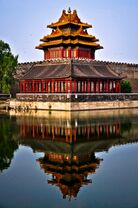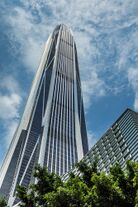Daedo: Difference between revisions
(Created page with "{{Infobox settlement | name = Daedo | other_name = | official_name = | native_name_lang = 대도특별시 | settleme...") |
No edit summary |
||
| Line 82: | Line 82: | ||
|footnotes = | |footnotes = | ||
}} | }} | ||
'''Daedo''' ([[Classic Zhenian]]: '''大都''', [[Zhenian language#Modern Zhenian|Modern Zhenian]]: ‘’’대도’’’, meaning 'Great Capital' in Zhenian), formally '''Daedo Special City''' ([[Classic Zhenian]]: '''大都特別市''', {{wp|Korean|Modern Zhenian}}: '''대도특별시'''), is the capital and [[List of Cities of Zhenia by Population|most populous]] city of the [[Greater Eastern Union of Zhenia]]. As the only city in the nation administratively designated as a [[Zhenia#Administrative Areas|special city]], it is governed by the [[Daedo Metropolitan Government]]. It faces the [[Gulf of Danguk]] to the west and is surrounded by [[ | '''Daedo''' ([[Classic Zhenian]]: '''大都''', [[Zhenian language#Modern Zhenian|Modern Zhenian]]: ‘’’대도’’’, meaning 'Great Capital' in Zhenian), formally '''Daedo Special City''' ([[Classic Zhenian]]: '''大都特別市''', {{wp|Korean|Modern Zhenian}}: '''대도특별시'''), is the capital and [[List of Cities of Zhenia by Population|most populous]] city of the [[Greater Eastern Union of Zhenia]]. As the only city in the nation administratively designated as a [[Zhenia#Administrative Areas|special city]], it is governed by the [[Daedo Metropolitan Government]]. It faces the [[Gulf of Danguk]] to the west and is surrounded by [[Chungmu Province]], while the [[Danbon River]], before emptying into the Gulf of Zhen, passes right through it. Subdivided into 17 districts, it is home to over 21.6 million residents, making it - with parts of the adjacent Chungmu Province - the single largest metropolitan area in the nation. | ||
With historical records detailing its existence dating its origins back to 68 AD, Daedo became the capital of the [[Jin dynasty]] in 981, after the royal house relocated from [[Junggyeong]]. Although it was burned to the ground by the Kharlin Empire and later faced decline upon the establishment of the [[Shindan|Shindan dynasty]], [[Emperor Seongjo of Shindan|Emperor Seongjo]] declared the city the new capital of the Empire, initiating its age of resurgence. Daedo eventually grew to be the heart of the Greater Eastern Union, rising to be a primary commercial and financial hub in the Asia-Pacific region. The Zhenian reconstruction effort after the Second World War also helped, as Daedo became the core and symbol of Zhenian resurrection - it hosted the [[1988 Daedo Olympics]] as well as some of the games during the [[2006 FIFA World Cup Zhenia]]. | With historical records detailing its existence dating its origins back to 68 AD, Daedo became the capital of the [[Jin dynasty]] in 981, after the royal house relocated from [[Junggyeong]]. Although it was burned to the ground by the Kharlin Empire and later faced decline upon the establishment of the [[Shindan|Shindan dynasty]], [[Emperor Seongjo of Shindan|Emperor Seongjo]] declared the city the new capital of the Empire, initiating its age of resurgence. Daedo eventually grew to be the heart of the Greater Eastern Union, rising to be a primary commercial and financial hub in the Asia-Pacific region. The Zhenian reconstruction effort after the Second World War also helped, as Daedo became the core and symbol of Zhenian resurrection - it hosted the [[1988 Daedo Olympics]] as well as some of the games during the [[2006 FIFA World Cup Zhenia]]. | ||
| Line 122: | Line 122: | ||
==Politics== | ==Politics== | ||
===Federal Government=== | |||
===Metropolitan Government=== | |||
===Administrative Districts=== | |||
==Demographics== | ==Demographics== | ||
===History=== | |||
===Religion=== | |||
===Health=== | |||
==Education== | ==Education== | ||
==Economy== | ==Economy== | ||
===Industry=== | |||
===Trade, Business and Finance=== | |||
==Transport== | ==Transport== | ||
{{main|Transportation in Daedo}} | |||
As both the nation's capital and largest city, transportation in Daedo has been developed with its role as the central node of not only the Capital Metropolitan Area but also the entirety of the Danguk Peninsula and ultimately Zhenia in mind. As a result, it has some of the most developed transportation networks in the nation via road, rail, air and ultimately shipping. Its public transportation system, particularly its rapid transit network, is one of the largest in the world. | |||
===Rapid Transit=== | ===Rapid Transit=== | ||
====Rail==== | ====Rail==== | ||
The [[Daedo Metro]], often stylized as MTX, | |||
====Buses==== | ====Buses==== | ||
| Line 139: | Line 160: | ||
===Air=== | ===Air=== | ||
The city is served by two airports - [[Daedo Capital International Airport]], which is the primary international and domestic hub of the city, and | The city is served by two airports - [[Daedo Capital International Airport]], which is the primary international and domestic hub of the city, and [[Jinpo International Airport]], the former international hub of the city before Daedo Capital International Airport and currently the city's secondary hub. Daedo Capital International Airport, primarily serving international and cargo air traffic, opened in 1997, was built upon reclaimed land in the southwestern coastal region of the city to replace Jinpo International Airport as the city's international hub, although Jinpo Airport still offers a mix of domestic flights and some international flights as well as private charter flights. Both airports are connected to city center via the [[Daedo Airport Railway]] and the MTX. | ||
===Road Network=== | ===Road Network=== | ||
===Intercity Rail=== | |||
Apart from regional rapid transit services, Daedo is served by an array of intercity trains linking the city to various points across the nation. There are four [[Zhenia National Express|ZNX]] stations within city limits - [[Daedo Central Station]], [[Daedo South Station]], [[Daedo North Station]] and [[Shin Daedo Station]], all four of which are directly linked to one another by ZNX shuttles and MTX services. Other trains, such as the Shinjin Express and the Trans Danguk Railway, directly pass through the city. | |||
==Culture== | ==Culture== | ||
===Points of Interest=== | |||
==See Also== | ==See Also== | ||
Revision as of 08:13, 1 February 2020
Daedo | |
|---|---|
Special City | |
| Nickname(s): City of the East, Dragon City, The City | |
| Motto(s): 고요한 아침의 수도 ("Capital of the Morning Calm.") | |
| Country | |
| Special City | Daedo Special District (coterminous) |
| Subdivisions | Districts
|
| Daedo founded | c. 68 AD |
| District Division | Capital District |
| Government | |
| • Type | Daedo Metropolitan Assembly |
| • Elected body | Daedo Metropolitan Assembly |
| • Mayor | Seungjun Jin (N) |
| • Senator | 5 senators |
| Area | |
| • Special City | 6,719.5 km2 (2,594.4 sq mi) |
| • Land | 6,001.3 km2 (2,317.1 sq mi) |
| • Water | 718.2 km2 (277.3 sq mi) |
| Highest elevation | 442.3 m (1,451.1 ft) |
| Lowest elevation | −0.7 m (−2.3 ft) |
| Population (2019) | |
| • Density | 3,217.1/km2 (8,332/sq mi) |
| • Metro | 21,617,281 |
| Demonym | Daedoite/Easterner |
| Time zone | UTC+09:00 (Zhenia Eastern Standard Zone (ZEST)) |
| ZIP Code | 00001-00100 |
| Zhenia Federal Area Code | 02 |
| City Flower | Zhenian Peony |
| Website | www.Daedocity.zhen.gov |
Daedo (Classic Zhenian: 大都, Modern Zhenian: ‘’’대도’’’, meaning 'Great Capital' in Zhenian), formally Daedo Special City (Classic Zhenian: 大都特別市, Modern Zhenian: 대도특별시), is the capital and most populous city of the Greater Eastern Union of Zhenia. As the only city in the nation administratively designated as a special city, it is governed by the Daedo Metropolitan Government. It faces the Gulf of Danguk to the west and is surrounded by Chungmu Province, while the Danbon River, before emptying into the Gulf of Zhen, passes right through it. Subdivided into 17 districts, it is home to over 21.6 million residents, making it - with parts of the adjacent Chungmu Province - the single largest metropolitan area in the nation.
With historical records detailing its existence dating its origins back to 68 AD, Daedo became the capital of the Jin dynasty in 981, after the royal house relocated from Junggyeong. Although it was burned to the ground by the Kharlin Empire and later faced decline upon the establishment of the Shindan dynasty, Emperor Seongjo declared the city the new capital of the Empire, initiating its age of resurgence. Daedo eventually grew to be the heart of the Greater Eastern Union, rising to be a primary commercial and financial hub in the Asia-Pacific region. The Zhenian reconstruction effort after the Second World War also helped, as Daedo became the core and symbol of Zhenian resurrection - it hosted the 1988 Daedo Olympics as well as some of the games during the 2006 FIFA World Cup Zhenia.
Etymology
History
Before the Shindan dynasty
The Shindan dynasty and the Empire of Zhenia
The Greater Eastern Union
Geography
Climate
| Daedo, Zhenia | ||||||||||||||||||||||||||||||||||||||||||||||||||||||||||||
|---|---|---|---|---|---|---|---|---|---|---|---|---|---|---|---|---|---|---|---|---|---|---|---|---|---|---|---|---|---|---|---|---|---|---|---|---|---|---|---|---|---|---|---|---|---|---|---|---|---|---|---|---|---|---|---|---|---|---|---|---|
| Climate chart (explanation) | ||||||||||||||||||||||||||||||||||||||||||||||||||||||||||||
| ||||||||||||||||||||||||||||||||||||||||||||||||||||||||||||
| ||||||||||||||||||||||||||||||||||||||||||||||||||||||||||||
Daedo's climate has a Koppen classification of Cw, indicating a high concentration of yearly precipitation in the summer seasons and generally dry winters, with the regional climate under considerable influence from seasonal winds to the north and south. While spring and fall seasons tend to see lower precipitation, a vast majority of the city's precipitation is focused on June, July and August.
Politics
Federal Government
Metropolitan Government
Administrative Districts
Demographics
History
Religion
Health
Education
Economy
Industry
Trade, Business and Finance
Transport
As both the nation's capital and largest city, transportation in Daedo has been developed with its role as the central node of not only the Capital Metropolitan Area but also the entirety of the Danguk Peninsula and ultimately Zhenia in mind. As a result, it has some of the most developed transportation networks in the nation via road, rail, air and ultimately shipping. Its public transportation system, particularly its rapid transit network, is one of the largest in the world.
Rapid Transit
Rail
The Daedo Metro, often stylized as MTX,
Buses
Air
The city is served by two airports - Daedo Capital International Airport, which is the primary international and domestic hub of the city, and Jinpo International Airport, the former international hub of the city before Daedo Capital International Airport and currently the city's secondary hub. Daedo Capital International Airport, primarily serving international and cargo air traffic, opened in 1997, was built upon reclaimed land in the southwestern coastal region of the city to replace Jinpo International Airport as the city's international hub, although Jinpo Airport still offers a mix of domestic flights and some international flights as well as private charter flights. Both airports are connected to city center via the Daedo Airport Railway and the MTX.
Road Network
Intercity Rail
Apart from regional rapid transit services, Daedo is served by an array of intercity trains linking the city to various points across the nation. There are four ZNX stations within city limits - Daedo Central Station, Daedo South Station, Daedo North Station and Shin Daedo Station, all four of which are directly linked to one another by ZNX shuttles and MTX services. Other trains, such as the Shinjin Express and the Trans Danguk Railway, directly pass through the city.






